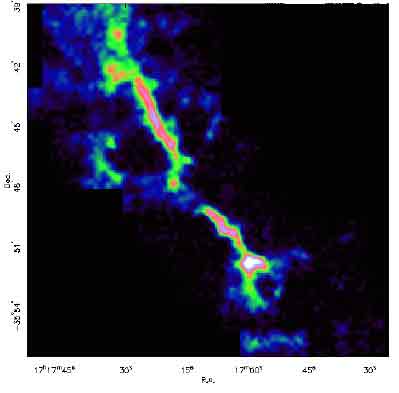|
||||
|
Large-scale Mapping of CO Emission in the NGC 6334 Region The image below shows the distribution of C18O J=2-1 emission within the large star-forming region NGC6334 in Scorpius (at l = 351.2, b = 0.5) at a distance of about 1700 parsec. The CO emission has been integrated over the narrow velocity range of -3.5 to -1.5 km/sec to show to good effect one particular feature, the narrow ridge of molecular gas running from top left to bottom right.
An 800 mm continuum map made by Sandell and Baas, which covers only the top 40% of this map, shows that the narrow ridge also contains dust emission. On the basis of a large body of published data, the NGC6334 complex contains five major sites of star formation activity, which are aligned roughly with the molecular ridge. NGC6334 appears also to be a region where sequential star formation has occurred. The sites in the southwest (lower right) appear to be the oldest, and those at the top, the youngest and apparently still ongoing. The active star-forming sites in the north (NGC6334I, I(N), II) lie somewhat to the east of the molecular ridge, while the southernmost (NGC6334V) lies to the west of it. The bright knot of emission at the southern end of the molecular ridge corresponds with NGC6334IV. One of the goals in this project is to study the properties of these sites as seen in their CO and CS emissions. H.E.Matthews, JAC & Herzberg Insitute of Astrophyics, NRCC, W.H. McCutcheon, University of British Columbia, G.J.White, Queen Mary and Westfield College, London |
|
|

